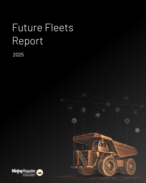Published in May 2006 Australian Mining Monthly
The Mt Owen Mine is located in the Hunter coal fields northwest of Singleton and incorporates an area of the Ravensworth State Forest that is considered to be regionally significant remnant vegetation. According to 1995 surveys, that land is home to more than 223 fauna species, including 19 species listed under the NSW Threatened Species Conservation Act 1995.
Agriculture, mining and urban development have all contributed to the clearing of native vegetation in the central Hunter Valley floor. To compensate for the loss of vegetation and habitat caused by mining in the area, Xstrata Mt Owen is implementing a comprehensive biodiversity management program.
Xstrata Mt Owen environment and community officer Nigel Charnock explained that under the program the company was committed to protecting and rehabilitating an area of forest and degraded pastureland for conservation.
In total, more than 1774 hectares of native forest will be established over the life of the mine.
“Xstrata Mt Owen’s commitment and efforts in relation to biodiversity management at Mt Owen will result in a significantly larger conservation area of increased biodiversity value than existed prior to mining, and assist with the achievement of biodiversity objectives for the wider Hunter Valley,” Charnock said.
The key components of the biodiversity management program include the establishment and management of biodiversity conservation areas to offset mining impacts, a progressive rehabilitation of disturbed areas to native forest and woodland, and a comprehensive flora and fauna management and monitoring program.
Wildlife species to have their native habitat protected under the Mt Owen program include the colourful swift parrot and the formidable powerful owl, species that have only recently been identified at Mt Owen Mine.
Xstrata Mt Owen has already demonstrated the effectiveness of artificial nesting boxes for roosting and breeding by some woodland bat species, woodland bird species and the squirrel glider. It has also studied the movement of native fauna species into reafforestation areas surrounding the Ravensworth State Forest.
Charnock said the program would lead to the identification of cost-effective methods for the establishment of native forest communities on rehabilitated mine land and the addition of 430ha to the Ravensworth State Forest.
“A diverse selection of native canopy, shrub and ground cover species has been established in rehabilitation areas and trial plots have been set up for exploring the most cost-effective methods for establishing native forest and woodland communities on mined land and in buffer areas.”
The program has already resulted in significant benefits, including the identification of new flora and fauna species recorded in the remnants of the Ravensworth State Forest.
It is also being backed up by comprehensive flora and fauna monitoring and an ongoing program of native forest restoration research.
Xstrata Mt Owen, in collaboration with Newcastle University academic staff and students, has established a long-term research program to determine the best practice methods for restoring degraded pastureland and mined land to a sustainable woodland forest ecosystem.
The research being conducted at Mt Owen Mine has benefits for the establishment of native forests beyond the Mt Owen boundaries and will be useful to anyone looking to establish native forest communities, according to Charnock.
“In the short term, Mt Owen’s biodiversity management program should ensure the protection of existing flora and fauna communities within the Mt Owen project area, while in the long term there is potential for the main reserve to be joined via corridors to other remnant vegetation on the floor of the Hunter Valley and adjacent footslopes,” he said.
“Appropriate security arrangements will ensure that conservation areas are protected and managed to enhance their ecological values in the long term.”
The Biodiversity Management Program at Xstrata Mt Owen, which forms part of Xstrata Coal’s broader NSW biodiversity and land management commitments, was initiated by the former Hunter Valley Coal Corporation.
The Coal Industry Environment awards, which are coordinated by a steering committee with representatives from the Department of Primary Industries, the Hunter Coal Environment Group, Hunter Councils and Minewatch, are held biennially and hosted by the Hunter-Central Rivers CMA.
Coal & Allied also received a commendation in the awards for its total waste management system. Coal & Allied recognised the positive impact it could have by doing more to recycle wastes being generated across its operations and reducing the amount of waste going to public landfill.
Thiess contractors were employed to custom develop a comprehensive waste handling, monitoring and tracking system that could be used by all parts of the business for managing the multiple waste streams generated by the mining operations.
























